Japan
Wood Products Prices
Dollar Exchange Rates of 25th
Jul
2023
Japan Yen 144.10
Reports From Japan
Covid downgrade
boosted business optimism
An Asahi Shimbun survey of business sentiment among 100 major companies
found that 76 viewed the domestic economy as “expanding” or “gradually
expanding” an increase of 30 companies from the previous survey in November
2022.
Many corporate leaders expressed optimism that economic activity and
personal consumption is rising now that COVID-19 has been downgraded to the
equivalent of seasonal flu. However, concerns remain about labour shortages
and a slowdown in global demand.
The Asahi Shimbun reports:
75 companies said the domestic economy is “gradually expanding.”
22 companies viewed the economy as “at a standstill”, half that of the
previous survey.
When asked to choose two reasons for their assessment most companies said
their optimism was due to the recovery of personal consumption.”
See:
https://www.asahi.com/ajw/articles/14965289
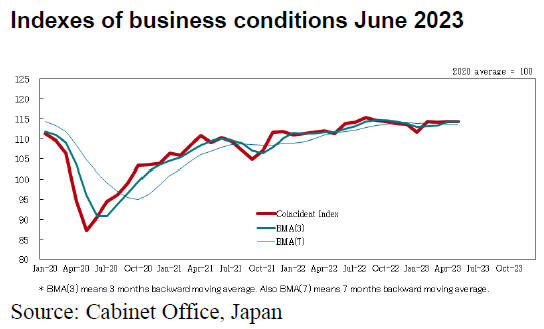
BoJ needs to see robust domestic demand and higher wage growth before
change of direction
Because inflation continues to exceed the Bank of Japan (BoJ) 2% target the
government cut the growth forecast but acknowledged growing signs of change
in the country's deflationary mindset.
According to the Prime Minister Japan's economy is recovering moderately
with positive signs emerging such as wage increases and encouraging
corporate investment.
In the mid-year review of its forecasts the government expects the economy
to expand in the fiscal year ending in March 2024 despite declining exports
as global demand slows. The government expects robust domestic consumption
and capital expenditure to support growth in fiscal 2024.
The BoJ governor has dismissed suggestions of an early exit from the Bank’s
ultra-loose policy saying the recent cost-driven rise in inflation must be
replaced by price gains driven more by robust domestic demand and higher
wage growth.
A recent survey of households by the BoJ found inflation expectations rose
in the second quarter 2023 which, if sustained, could signal that conditions
for phasing out massive monetary stimulus may be falling into place. The
ratio of Japanese households expecting prices to rise a year from now stood
at 86% in June, up from March to the highest level since June 2022.
See:
https://asia.nikkei.com/Economy/Japan-cuts-growth-forecast-sees-inflation-exceeding-BOJ-target
and
https://www.japantimes.co.jp/news/2023/07/12/business/japan-households-inflation-survey/
Major retailer to build stores with domestic wood
Muji, the Japanese retailer which sells a wide variety of household and
consumer goods and which places emphasis on recycling, reducing production
and packaging waste, plans to construct 20 stores made of domestic timber.
The idea to utilise domestic timber is part of the company’s sustainable
business model. The company has concluded an agreement with the Ministry
Agriculture, Forestry and Fisheries which is promoting the use of domestic
timber.
See:
https://japannews.yomiuri.co.jp/business/companies/20230601-113282/
Changing demographics to impact timber consumption
There was a drop in the number of citizens in Japan in 2022 with all 47
prefectures seeing declines for the first time. However, the number of
non-Japanese residents surged to a record high balancing out some of the
population loss.
Data from the Ministry of Internal Affairs revealed that the population of
Japanese nationals stood at around 122.42 million as of 1 January 2022 a
decrease of over 800,000 year on year and the 14th year-on-year decline.
This change in demographics will impact demand for new homes and consumption
patterns as many of the foreign workers are short-term workersand many are
in low paying jobs.
See:
https://www.japantimes.co.jp/news/2023/07/26/japan/society/number-of-japanese-drops-in-all-47-prefectures-for-first-time-as-foreign-population-surges/

Home prices rising
Residential property prices continue to rise in Japan despite weakening
demand and the economic slowdown. During 2022 the nationwide residential
property price index rose by 7.5% an acceleration from y-o-y rises of 6.3%
in 2021, 3.1% in 2020 and 0.6% in 2019, according to Land Institute of Japan
data.
The house price growth continued early this year but there are wide price
variations in terms of location and property type. In the first quarter 2023
existing detached house prices were up by 4.7% y-o-y after an annual growth
of 8.3% in the first quarter 2022.
The outlook for Japan’s housing market is tough to forecast because of cost
push inflation and heightened economic uncertainty. Demand remained weak in
early 2023.
In Tokyo, sales of both existing condo units and detached houses fell by
1.1% and 5.5%, respectively, in the first quarter of this year compared to
the same period in 2022.
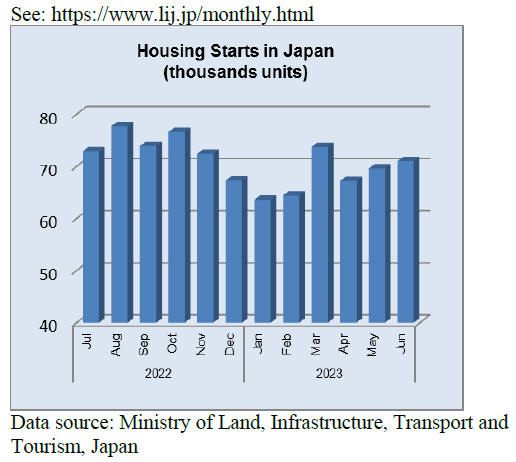
Weak yen of concern, BoJ holds the key
The yen dropped to 144 against to the dollar in late July, held down by
clear indications the BoJ will not be changing its policy in the short-term.
The BoJ has indicated it will need to see a sustainable link between wages
and inflation before changing its policy. The question is, when will a
policy change come? as this will be a market moving event.
Recent data showed Japan's core inflation rose to 3.3%, well above the BoJ
target. At its policy board meeting at the end of July expressions used in
the report and in the press conference have been interpreted as possibly
signaling a change in policy direction. This sent the yen firmer against the
US dollar but whether this will be sustained is the question.
See:
https://www.reuters.com/markets/currencies/dollar-firms-yen-steady-after-japan-inflation-holds-above-boj-target-2023-07-21/
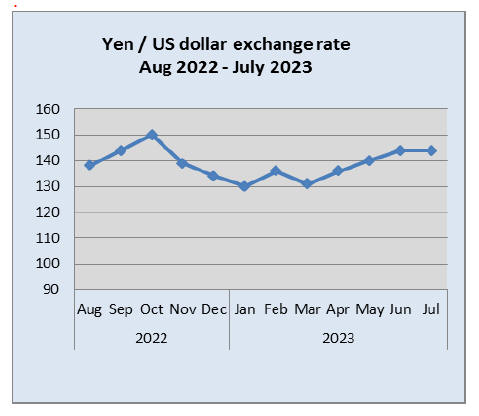
Import update
May marked the second consecutive decline in the value
of imports of office, kitchen and bedroom furniture and
wooden furniture parts. This comes at a time when
consumers are reeling from across-the-board price
increases and when inflation has eaten away the wages
increases agreed earlier in the year.
Since the third quarter of 2022 the monthly value of
furniture imports has become less predictable. For each of
the three of the furniture categories tracked, wooden
office, kitchen and bedroom furniture, monthly import
values have swung widely, a feature not seen before in
Japanese furniture imports.
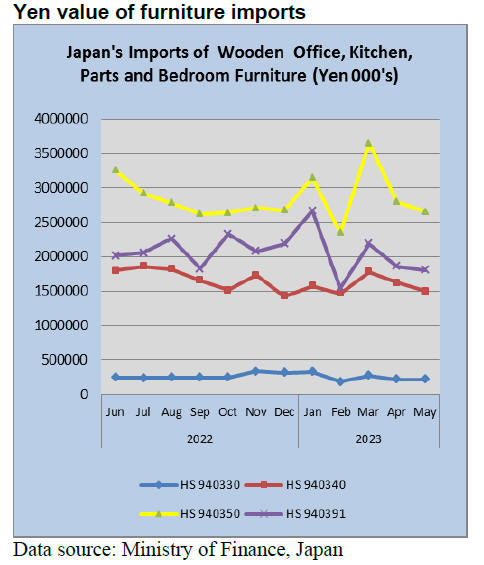
May wooden office furniture imports (HS 940330)
The value of wooden office furniture imports in May this
year were around 13% higher than in May 2022 but the
value of May imports were little changed from the level
seen in April.
May shipments of wooden office furniture from China to
Japan accounted for over 77% of all wooden office
furniture imports, a slight rise on the 75% in April. In May
there was a shuffling amongst the other main shippers with
shipments from Vietnam dropping to less than a quarter of
April shipments and two new suppliers, Canada and
Singapore surging to become the second and third largest
shippers. Exporters in Poland have a steady business with
Japan but in May the value of shipments dropped by over
50%.
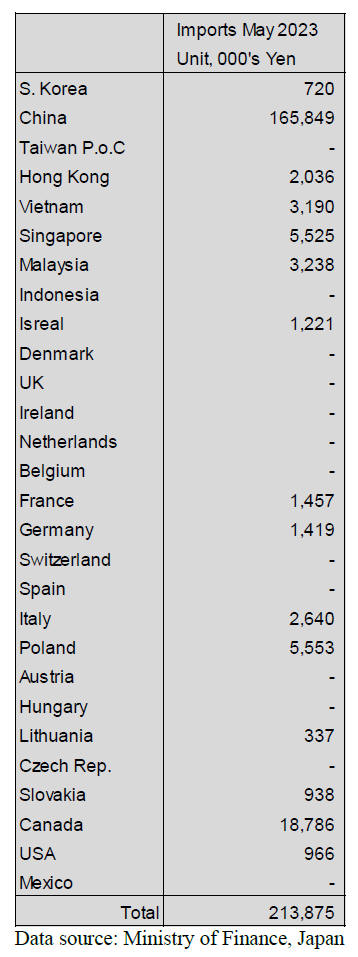
May kitchen furniture imports (HS 940340)
The value of May 2023 imports of wooden kitchen
furniture was some 11% below that recorded in April and
also 11% below that recorded in May 2022. All the top
suppliers saw shipment values drop.
The Philippines was the top supplier in May but shipments
were down 5%, shipments from Vietnam were down 14%,
shipments from Italy were down around 15%, however,
shippers in China gained a greater share of the value of
wooden kitchen furniture imports.
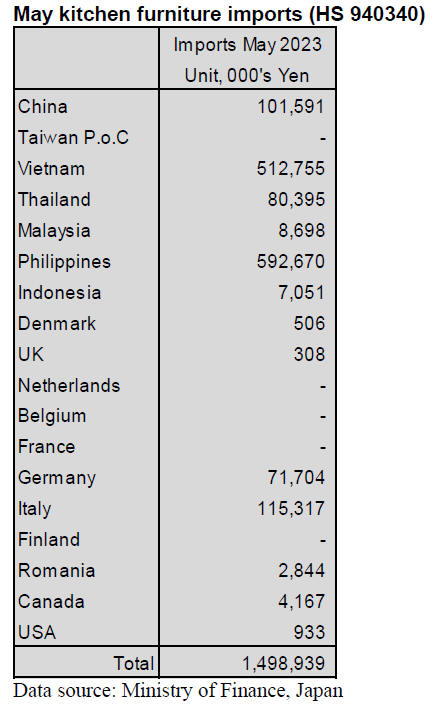
May wooden bedroom furniture imports (HS 940350)
After the sharp rise in the value of shipments of wooden
bedroom furniture in March, there was a decline in April
and the down-trend continued into May. Year on year, the
value of May wooden bedroom furniture arrivals was
down 18% and compared to the value of April imports
there was a further 5% decline.
The top supplier, China, accounted for just over 60% of all
wooden bedroom furniture imports in May and the value
of imports was around the same level as in April. The
second largest supplier, Vietnam saw the value of imports
drop 12% compared to a month earlier. For the third
largest supplier, Malaysia, the value of May shipments
was down over 20%. These top three suppliers accounted
for 97% of the value of all May wooden bedroom furniture
imports.
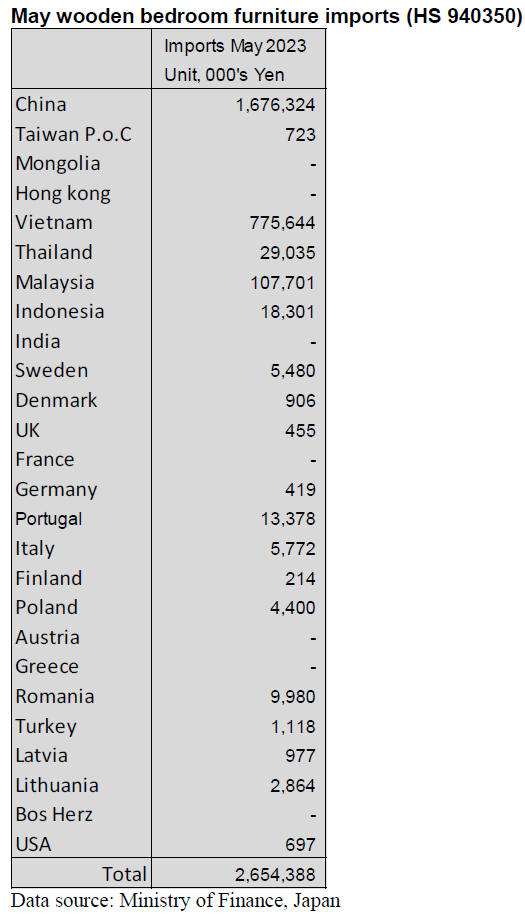
May wooden furniture parts imports (HS 940391)
Japan’s imports of wooden furniture parts (HS940391) are
substantial. Most imports of wooden furniture parts
originate in China and in May shipments from China
accounted for close to 50% of the value of all May
arrivals. Arrivals from Indonesia in May accounted for
15% followed by Vietnam 13% and Malaysia 8%.
Unlike the other categories of furniture, wooden furniture
parts imports into Japan come from a wide range of
sources but the top four suppliers in May accounted for
over 80% of all wooden furniture parts imports.

Trade news from the Japan Lumber Reports (JLR)
The Japan Lumber Reports (JLR), a subscription trade
journal published every two weeks in English, is
generously allowing the ITTO Tropical Timber Market
Report to reproduce news on the Japanese market
precisely as it appears in the JLR.
For the JLR report please see:
https://jfpj.jp/japan_lumber_reports/
Business suspension orders
The MAFF (Ministry of Agriculture, Forestry and
Fisheries) demands Pt Mutuagung Lestari in Indonesia and
Greenpanel Corporation in China to stop certifying JAS
(Japanese Agricultural Standards) on lumber and to
improve a way of certifying JAS on lumber.
Pt Mutuagung Lestari knew that structural plywood of
Benbenmao New Material Co., Ltd. in China was not good
enough to satisfy the conditions of JAS but Pt Mutuagung
Lestari did not take measures for that. Benbenmao New
Material is a plywood company which is not able to get
the JAS certification on lumber now.
Greenpanel Corporation authorized several companies as
certification authorities of JAS even though there were
errors on examinations. A term of a stop for operations of
Pt Mutuagung Lestari is 90 days, which is 19th July, 2023
to 16th October, 2023. Greenpanel Corporation stops an
operation during 19th July, 2023 to 16th September, 2023
for 60 days.
The MAFF demands on both companies to report about an
improvement of certificating JAS, a revision of the
organization, a cause of this case and measures to prevent
a relapse. A deadline of the report will be 17th September,
2023 for Pt Mutuagung Lestari and will be 18th August,
2023 for Greenpanel Corporation.
According to The FAMI (The Food and Agricultural
Materials Inspection Center), low formaldehyde structural
plywood was produced maximum 1,230,000 sheets, about
31,000 cbms and about 87,000 sheets, about 21,000 cbms,
were imported to Japan. Japanese importers sold at least
620,000 sheets, about 15,000 cbms, to the clients. The low
formaldehyde structural plywood was produced during
22nd February, 2022 to 17th September, 2022. The sizes
were 9 mm, 12 mm, 15 mm, 24 mm and 28 mm thickness,
190 mm width and 1,890 mm length.
Product of LVL was maximum 30,000 LVL, 300 cbms.
About 15,000 LVL, about 200 cbms, was imported to
Japan. Japanese importers sold 13,000 LVL, 110 cbms.
LVL was produced during 15th June, 2022 to 16 th
September, 2022. The sizes were 22 – 50 mm thickness,
40 – 910 mm width and 1,000 – 3,000 mm of length.
The FAMI found out that glue and quality of some
structural plywood used for houses were not satisfied the
conditions of JAS. However, the strength and the
emanated quantity of formaldehyde of structural plywood
satisfied the conditions of JAS.
The price of cedar log keeps falling
The price of cedar log has been plunging in Fukushima Prefecture since
March, 2023. The price of 3 m cedar log for posts and 4 m cedar log
decreased under 10,000 yen, delivered per cbm, in late June. This is for the
first time in three years to be under 10,000 yen. In some area, the price of
cedar log is about 8,000 yen, delivered per cbm.
Once the price of cedar log skyrocketed in April, 2021 due to the wood shock
and the average price of cedar log during April, 2021 to March, 2023 had
been around 14,000 – 15,000 yen, delivered per cbm. Some reasons are that
demand of log for producing lumber increased a lot in 2021 and there were
many inquiries about logs to manufacture plywood in 2022. Since the price
and demand were stabilized, it was able to cut down the trees and able to
supply logs stably. Also, there was movement of employment expansion.
However, demand of log started decreasing at the beginning of this year and
the log price also started decreasing.
3 m cedar log for producing posts costs 9,500 yen, delivered per cbm. 4 m
cedar log of medium diameter is 9,000 yen, delivered per cbm. There are many
logs left at the log markets. Cedar logs for manufacturing plywood are 9,000
– 10,000 yen, delivered per cbm. However, there are not many orders for
cedar logs.
Cedar logs for producing wooden chips are very popular now. The wooden chips
will be used for manufacturing paper and for manufacturing wooden biomass
fuels. The cedar logs for wooden chips are sold by 6,500 – 7,000 yen,
delivered per cbm.
Domestic logs in Northeast Japan
There are less logs in Northeast Japan because the price of softwood
logs had declined. Volume of log at the log markets is 20 % less than the
same period last year. Demand of log has not recovered yet and the price of
cedar log is still weak. The price of larch log has not changed because of
less larch logs at the log markets. Manufacturers still have a lot of cedar
logs. There is a concern that beetles would be on logs.
In Akita Prefecture, 3.65 m cedar log of medium diameter is 11,000 yen,
delivered per cbm. 3.65 m cedar log for post is 10,000 yen, delivered per
cbm. In Iwate, Miyagi and Aomori Prefecture, 4 m cedar log with medium
diameter is 10,000 yen, delivered per cbm and 3 m cedar log for post is
11,000 yen, delivered per cbm.
4 m larch log of medium diameter is 20,000 yen, delivered per cbm. For
piles, the price of larch log is 12,000 yen, delivered per cbm. For biomass
fuels, the price is 7,000 yen, delivered per ton.
Since there are many logs in Northeast Japan, the logs were exported China
but it would be difficult to export the logs anymore because the economy in
China is not good.
In this year, hardwood logs are popular and high-priced. Oak log of large
diameter is over 60,000 yen, delivered per cbm and of medium diameter is
over 40,000 yen, delivered per cbm. Japanese walnut log is with good quality
is 50,000 yen, delivered per cbm.
10 Japanese companies participate Eastwood Climate Smart Forestry Fund I
Sumitomo Forestry Co., Ltd. in Tokyo Prefecture announced that East
Forests LLC in the U.S.A. established Eastwood Climate Smart Forestry Fund I
(hereinafter, the Fund) and started an operation. 10 Japanese companies
participate this Fund and the operation will be fifteen years. It is about
six billion yen in assets.
Eastwood Forests was jointly established in October, 2022 by Sumitomo
Forestry’s wholly owned subsidiary Sumitomo Forestry America, Inc. and the
CEO of Eastwood Forests experts in establishing and managing forestry funds
in the U.S.A. Eastwood Forests will serve as the asset management company of
the Fund, providing advice on the management of forest assets. Sumitomo
Forestry’s wholly owned subsidiary SFC Asset Management Co., Ltd. handles
the Fund’s private placement and has been entrusted by the general partner
to manage operation in Japan.
10 Japanese companies, which participate this Fund, are ENEOS Corporation,
Osaka Gas Co., Ltd., Tokyo Century Corporation, Japan Post Holdings Co.,
Ltd., NYK Line, Fuyo General Lease Co., Ltd., Sumitomo Mitsui Banking
Corporation, Sumitomo Mitsu Trust Bank Limited, Unicharm Corporation and
Sumitomo Forestry.
The companies participate this Fund because some of them are to achieve a
goal of decarbonization and add value on their products or services.
South Sea logs and lumber
The weak yen has been influencing the price of South Sea lumber and
Chinese lumber. Once the yen depreciated over 135 yen against the dollar in
March, 2023. Chinese and Indonesian manufacturers accepted Japanese
importers’ request, which was a reduction in the price of lumber. However,
an amount of order was not a lot. In the beginning of July, the yen
depreciated to 145 yen against the dollar but it is difficult for Chinese
and Indonesian manufactures to lower the price. Japanese importers are
cautious to purchase South Sea or Chinese lumber even though the inventory
in Japan is not enough.
The price of Merkus pine lumber in Indonesia is US$820 – 850, C&F per cbm.
The price of red pine lumber in China is US$870 – 890, C&F per cbm. In
Japan, the price of Indonesian Merkus pine lumber is around 122,000 yen,
delivered per cbm. The price of Chinese red pine lumber is around 127,000
yen, delivered per cbm. Also, there is an influence of the weak yen for
South Sea lumber. Additionally, Indonesian manufacturers reduce producing
South Sea lumber and will be difficult to get South Sea logs. Therefore, it
is important to keep getting new orders even though the amount of order is
not a lot.
The price hike of painted (coated) plywood for concrete form
The price of painted plywood for concrete form in South Asia started to
rise. A major South Asian shipper will raise the price by US$10 – 20. It had
been hard for manufacturers in South Asia to get enough profits. Japanese
importers will definitely purchase plywood because their inventory is less.
The price will be depended on the negotiation and Japanese importers must
raise the price of plywood in Japan quickly.
The latest price of 12 mm thickness 3 x 6 is around US$650, C&F per cbm. The
import cost is around 1,890 yen, FOB per sheet, calculated by 139 yen
against the dollar. In Kanto region, the price is 1,850 – 1,900 yen,
delivered per sheet.
Some South Asian shippers raised the price after April, 2023. If the price
in South Asia were US$670, the import cost would be 2,020 yen FOB per sheet
calculated by 144 yen against the dollar. This would be 130 yen higher than
the previous time. If the import cost were 1,960 yen, FOB per sheet, the
plywood would be sold by 2,000 yen, delivered per sheet, in Japan.
At domestic markets, the price of plywood had been decreasing as the futures
price in South Asia decreased so Japanese buyers hesitated to purchase due
to anticipation of lowering prices. Arrival volume of plywood from Malaysia
during January to May, 2023 is 186,153 cbms, 48.3 % down from the same
period last year. Since product of plywood decreased, a major Indonesian
shipper struggles to get profits so the Indonesian shipper closed one of its
two plants and will raise the price.
In Japan, the inventory of plywood has been declining so Japanese importers
must order plywood. The inventory is now 40 – 50 % less than the highest
volume in October, 2022. The plywood will arrive in September, 2023 if the
Japanese importers order now.
Volume of imported plywood during January to May, 2023 is 784,712 cbms,
31.9% down from the same period last year. The prices of plywood and
structural plywood in South Asia has not reached the bottom price and if the
price of painted plywood for concrete from reached the bottom price, then
the price of imported South Sea plywood would get rid of all the negative
factors and would be ready to bounce back.
|